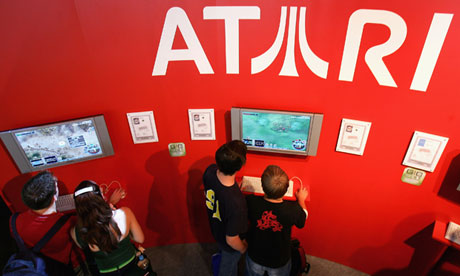
When Atari filed for bankruptcy, Ron Adner, a business professor at Dartmouth's Tuck School of Business, experienced the reaction that a lot of Americans probably did: "It's amazing that they lasted as long as they did. When was the last time you heard Atari in a sentence? Atari, as far as I know, was basically sunk 10, 15 years ago."
I grew up with Atari but, like Adner, I was surprised the brand was still alive, smuggled away under the rubric of a French parent company that is also filing for bankruptcy protection in Paris.
Our icons keep slipping away into bankruptcy. Before Atari there was Hostess and Polaroid. Kodak's patents, sold for a relatively small $525m, will live on at Samsung, Microsoft, Adobe, Apple, Facebook and others.
In every case, these iconic names had something valuable attached to them, besides memories. Hostess had its brands and its bakeries. Atari has its logo and its games – including Pong and Asteroid – and is hoping to find enough financing to come back in the world of digital games. (It may seem unjust to some that a world that embraces Zynga's Farmville can't find room for Atari's Centipede.)
This is all just the circle of life in Corporate America. Among companies, bankruptcy does not necessarily carry a stigma. It is commonly seen as a tool of innovation – or "creative destruction", as corporate types call it. The idea is that old ideas and companies and patents and brands get destroyed and composted into new, more beneficial ones.
This idea of creative destruction is fine for companies, but does it work for people? It's a little thornier there. People are the assets that these companies don't efficiently pass on to someone else. Hostess's bankruptcy in November left roughly 15,000 people immediately out of work. Kodak, which employed 145,000 people at its height, laid off 2,700 people last year.
These are the workers that CEOs say they are looking for: trained, with the ability to learn and use highly technical machinery. As these companies go out of business, those skilled workers are lost, even if temporarily, from the workforce.
Little by little, the ranks of skilled and unemployed workers grow from the layoffs of big corporations and well-known brands, even while corporations mostly complain about the lack of skilled workers. There is an unjust asymmetry here: corporations will think almost infinitely about what to do with brands and patents, but very little about how to retrain workers to suit new jobs.
What about these skilled workers? Where are they? They fall into a strange, invisible work force and it is hard to track what happens to them. Are they adding to the nation's unemployment figures? Are they moving across the country? It's hard to tell – and that's the problem. This skilled work force is the one that America depends on, and there should be better ways of not only counting them, but also retraining them.
Viral Acharya, a professor at NYU's Stern School of Business, believes that it is helpful for these companies to go out of business because it requires their employees to work on new efforts for innovation rather than being attached to old, dying technologies. "It would be bad if these companies didn't fold up in time, or else their workers won't adapt to new skills," he told me.
He added: "[Bankruptcy] is basically a recognition that this company is not working, and it's time for their workers to retool their abilities."
From a worker's point of view, however, there are very few ways to do that. Many corporations have brief outplacement advice and counseling, but that is designed to help workers find another job, not build new skills.
They would need training to work for other companies, but there is little such training available for people who are out of work – a fact that President Obama mentioned, briefly, in his inaugural address.
US competitiveness, and its ability to survive in a global economy, depends in part on creating the raw tools of a good workforce: education, job training, ways to pick up credentials. That nimbleness seems to be gone in America, even if entrepreneurs are still innovating in Silicon Valley. There are big thinkers, but fewer with the pragmatic knowledge to operate the machines. This is something that China, India and other competitive economies have on us, as Acharya points out.
So it's understandable if Americans bemoan the death of Hostess – even if they hadn't had a Twinkie since the Reagan administration – or weep for Kodak and Polaroid, missing their photographic paper and old cameras even though the iPhone and DSLRs had long ago made them unnecessary.
Atari, like Hostess, Kodak and Polaroid, lives on in the imaginations of many Americans as an iconic representation of times when giant American brands enjoyed a strong corporate foothold. The way to bring them back – and with them, that feeling of American competitiveness – is not necessarily to nurse their zombie brands to health. It is to bring their skilled employees back into the workforce, where they can work on creating something new.

